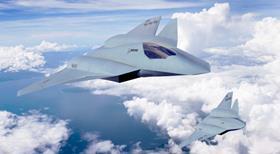The US Air Force (USAF) will refrain from making a decision on a much-watched sixth-generation fighter development programme, leaving the issue to the incoming administration of president-elect Donald Trump.
Uncertainty has swirled around the Next Generation Air Dominance (NGAD) programme for much of the past year, with air force secretary Frank Kendall saying the current prototype aircraft were proving too expensive for the service to procure in significant numbers.
Although he promised “answers over the next few months” at the 2024 Air & Spaces Forces Association conference in September, Kendall has apparently decided to leave the choice to his successor, following President Joe Biden’s electoral defeat in November.
“The secretary of the air force will defer the Next Generation Air Dominance way ahead decision to the next administration,” the USAF announced on 5 December.
Alongside the secretary of defense, civilian leaders of each US military service are appointed by the president. These political officials typically depart public service during a change in government, meaning Kendall is unlikely to retain his job under the second Trump administration.

Ahead of his inauguration in January, Trump has already named his choices to oversee the US Army and navy, and to be secretary of defense. Kendall has played a key role in many of the air force’s signature modernisation efforts and in September said he would be open to staying on with the new administration to continue that work.
Whomever occupies the secretary’s chair in 2025 will face a decision about how to proceed with NGAD. The Department of the Air Force says its career staff will continue with the “necessary actions to ensure decision space remains intact for the NGAD programme”.

These include extending the current research and development contracts to “further mature designs and systems while ensuring the industry teams remain intact”, the air force says.
The NGAD programme is highly classified and the Pentagon has not publicly disclosed which firms are involved. Both Boeing and Lockheed Martin are widely believed to be finalists, after Northrop Grumman publicly bowed out in 2023.
Boeing has gone so far as investing nearly $2 billion to build a classified factory for the production of “future combat aircraft programmes”, though company officials say there is no official link to the secretive NGAD.
While the US Navy recently reaffirmed its commitment to fielding a sixth-generation fighter, Kendall and other air force leaders have been less resolute in recent months.
The NGAD concept, which Kendall describes as “essentially an F-22 replacement”, was conceived before the air force’s more recent pivot toward low-cost autonomous fighters.
Kendall in September revealed that the current NGAD prototypes, which are conventionally manned, would carry a price tag equivalent to multiple Lockheed F-35 stealth fighters, which the Pentagon is currently buying in large numbers.
“We need a unit cost that is affordable in significant quantities,” Kendall said.

It is unclear how the future Trump administration might rule on NGAD. Trump himself, along with key advisers including the industrialist and space pioneer Elon Musk, have previously been highly-critical of traditional defence manufacturers.
During his first turn in the White House, Trump famously took Boeing to task on the VC-25B contract to deliver two new “Air Force One” executive jets.
Musk meanwhile critiqued the entire concept of manned fighter aircraft in recent days, singling out the F-35 in particular.
“Some idiots are still building manned fighter jets like the F-35,” the billionaire posted on the social media site X (which Musk owns) in November, beneath a video depicting swarms of small quadcopters launching in a dense formation.
Musk went on to express a preference for reusable drones over crewed fighter jets, calling manned aircraft “inefficient” and noting that they bear extra costs associated with human pilots.
Industry experts and retired officers have pushed back, noting that much of the F-35’s cost comes from the jets’ advanced sensors, communications and weapon systems – at least some of which would presumably be incorporated into future autonomous fighters.
Despite criticism, the F-35 has proved popular, with 20 countries worldwide now signed on to operate the advanced stealth fighter, including several commitments in the past two years.
Romania became the latest member of the F-35 club, signing a letter of offer and acceptance in November covering 32 aircraft at a price of up to $7.2 billion.


























